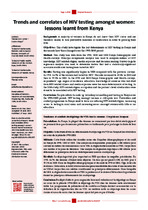| dc.contributor.author | Achia, Thomas N.O. | |
| dc.contributor.author | Obayo, Eunice | |
| dc.date.accessioned | 2016-08-12T10:40:01Z | |
| dc.date.available | 2016-08-12T10:40:01Z | |
| dc.date.issued | 2013 | |
| dc.identifier.citation | Achia, T.N.O. and Obayo, A.E. (2013). Trends and correlates of HIV testing amongst women: lessons learnt from Kenya. African Journal of Primary Health Care & Family Medicine, 5(1): 1-10 | en_US |
| dc.identifier.issn | 2071-2936 | |
| dc.identifier.uri | http://hdl.handle.net/10566/2373 | |
| dc.description.abstract | BACKGROUND: A majority of women in Kenya do not know their HIV status and are
therefore unable to take preventive measures or medication in order to prolong their
lives.
OBJECTIVES: This study investigates the key determinants of HIV testing in Kenya and
documents how these changed over the 1998-2008 period.
METHOD: This study uses data from the 1998, 2003 and 2008 Kenya Demographic and
Health surveys. Principal components analysis was used to compute indices of HIV
knowledge, HIV-related stigma, media exposure and decision making. Survey logistic
regression analysis was used to determine factors that had a statistically-significant
association with ever having been tested for HIV.
RESULTS: Testing was significantly higher in 2008 compared with the previous surveys.
In 1998, 14.7% of the women had tested for HIV. The rate increased to 15.0% in 2003 and
then to 59.2% in 2008. In the 1998 and 2003 Kenya Demographic and Health surveys,
respondents' age, region of residence, education, knowledge of someone who had died
from HIV-related illness and media exposure were the main determinants of testing. In
the 2008 study, HIV-related stigma, occupation and the partner's level of education were
found to be associated with HIV testing.
CONCLUSION: Despite efforts to scale up voluntary counselling and testing in Kenya over
the 1998-2008 period, HIV testing amongst women is still quite low. Prevention and
control programmes in Kenya need to focus on reducing HIV-related stigma, increasing
access to testing in rural areas and increasing access amongst women with little or no
education. | en_US |
| dc.language.iso | en | en_US |
| dc.publisher | AOSIS | |
| dc.rights.uri | http://creativecommons.org/licenses/by/4.0 | |
| dc.source.uri | http://dx.doi.org/10.4102/phcfm.v5i1.547 | |
| dc.subject | HIV testing | en_US |
| dc.subject | Women in Kenya | en_US |
| dc.subject | Prevention | en_US |
| dc.subject | Demographic and Health surveys | en_US |
| dc.subject | Voluntary HIV Counselling and Testing (VCT) | en_US |
| dc.title | Trends and correlates of HIV testing amongst women:
lessons learnt from Kenya | en_US |
| dc.type | Article | en_US |
| dc.privacy.showsubmitter | FALSE | |
| dc.status.ispeerreviewed | TRUE | |
| dc.description.accreditation | DHET | en_US |


